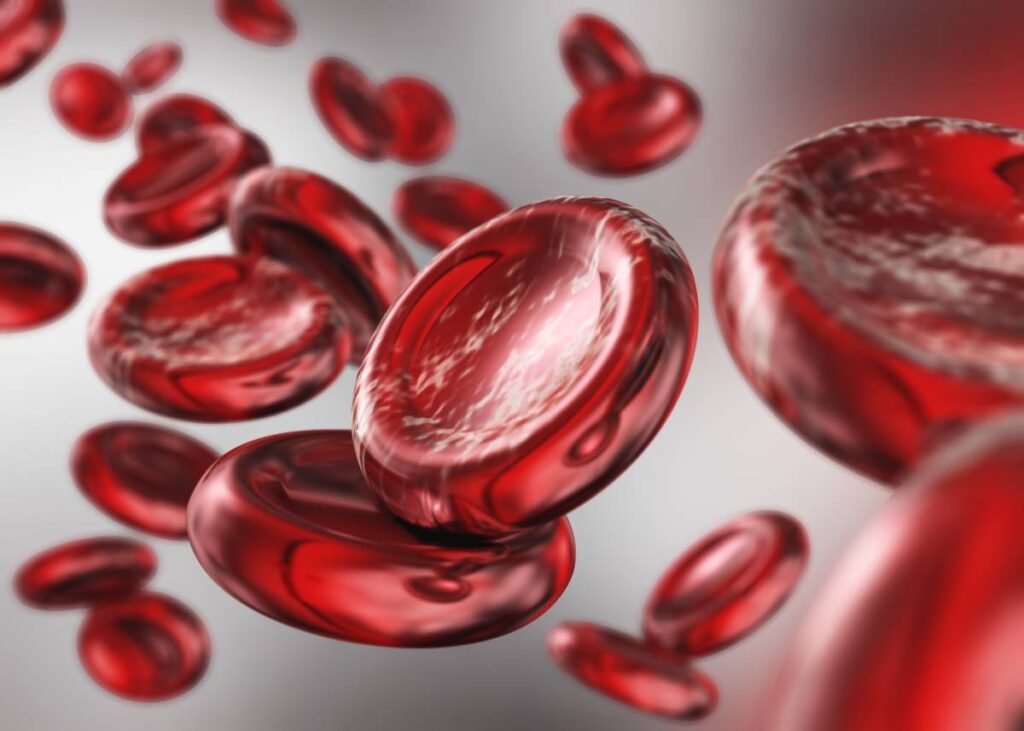In humans and some primates, blood is classified into blood types on the basis of certain antigens and antibodies it contains. Red blood cells (RBCs) contain antigens – which can be carbohydrates or proteins – on the extracellular surface of the RBC membrane [1]. The two main antigen groups are the ABO and Rh groups. People with blood type A contain the A antigen on their RBCs, while blood type B is characterized by the B antigen on RBCs. Those with both antigens are classified as AB, and those lacking both are in group O. Additionally, RBCs can carry a Rhesus factor (Rh), and the 85% of people who have this factor are considered Rh positive [2]. The most common blood type worldwide is O+ [3], in which neither the A or B antigen is present but the Rh factor is.
The presence of antigens on the surface of RBCs is directly correlated with the presence of antibodies against the other RBC antigens in the blood serum. Individuals with type A blood, for example, carry anti-B antibodies, while type O blood contains anti-A and anti-B antibodies. Blood antigens and antibodies were discovered by Austrian scientist Karl Landsteiner in the early 20th century, who observed that the RBCs of certain individuals agglutinated (clumped together) when mixed with the blood serum of other individuals [4]. He postulated that this resulted from the reaction of antigens on the surface of RBCs with antibodies in the serum, which was later corroborated by genetic and biochemical analyses.
Knowing the blood type of the donor and recipient during a blood transfusion is critical. Blood transfusions are commonly used to replace blood lost during surgery and injury or to provide blood components that the recipient does not naturally make [5]. Mismatched transfusions result in severe intravascular hemolysis caused by the immune reaction of the antibodies circulating in the recipient’s bloodstream with the RBC antigens of donor blood [6]. Though exceedingly rare [7], mismatched transfusions are highly dangerous, and blood types are thus routinely checked before a transfusion to ensure the donor and recipient are a match.
There are other potential complications that, while also rare, may arise from blood transfusions. In the early 1980s, it was discovered that HIV could be transmitted through a blood transfusion, and HIV-antibody testing was subsequently introduced to prevent this outcome [8]. Transfusion-related acute lung injury is characterized by acute respiratory distress that begins within hours of a transfusion and occurs when antibodies in donor blood damage the pulmonary vasculature [9].
These and other risks, combined with the rise in patients who choose to avoid blood transfusions out of religious and personal convictions, have led to the rise of “bloodless medicine” programs that reduce or eliminate the need for transfusions. Bloodless medicine minimizes blood loss through minimally invasive surgical techniques and preoperative techniques such as iron administration, which stimulates a patient’s own production of RBCs [10]. Studies comparing the outcomes of patients in bloodless programs compared to those receiving transfusions have been favorable, with the bloodless group showing lower mortality and hospital costs [11]. These findings may motivate others, even those with no religious objections to transfusions, to gravitate towards bloodless options when seeking blood-related treatment.
References
- Reid, M. E. & Mohandas, N. Red blood cell blood group antigens: structure and function. Semin. Hematol. 41, 93–117 (2004).
- Blood Types | NorthShore. https://www.northshore.org/community-events/donating-blood/blood-types/.
- Blood types. NHS Blood Donation. https://www.blood.co.uk/why-give-blood/blood-types/.
- Dean, L. The ABO blood group. Blood Groups and Red Cell Antigens [Internet] (National Center for Biotechnology Information (US), 2005).
- Blood transfusion – Mayo Clinic. https://www.mayoclinic.org/tests-procedures/blood-transfusion/about/pac-20385168.
- Rudlof, B., Just, B.,Deitenbeck, R. & Ehmann, T. Mismatched transfusion of 8 AB0-incompatible units of packed red blood cells in a patient with acute intermittent porphyria.Saudi J. Anaesth. 5, 101–104 (2011).
- Asano, T., Koizumi, S. &Fujino, O. Transient thrombocytopenia after incompatible red blood transfusion in an infant girl with autoimmune hemolytic anemia.J. Nippon Med. Sch. Nippon Ika Daigaku Zasshi 73, 93–96 (2006).
- Centers for Disease Control (CDC). Provisional Public Health Service inter-agency recommendations for screening donated blood and plasma for antibody to the virus causing acquired immunodeficiency syndrome. MMWRMorb. Mortal. Wkly. Rep. 34, 1–5 (1985).
- Cho, M. S., Modi, P. & Sharma, S. Transfusion-related Acute Lung Injury. inStatPearls (StatPearls Publishing, 2021).
- Resar, L. M. S.et al.Bloodless medicine: current strategies and emerging treatment paradigms. Transfusion (Paris) 56, 2637–2647 (2016).
- Frank, S. M. et al.Risk-adjusted clinical outcomes in patients enrolled in a bloodless program. Transfusion (Paris) 54, 2668–2677 (2014).



